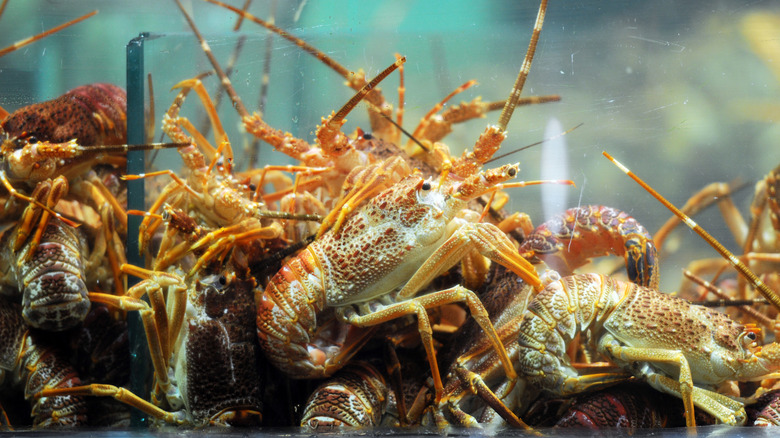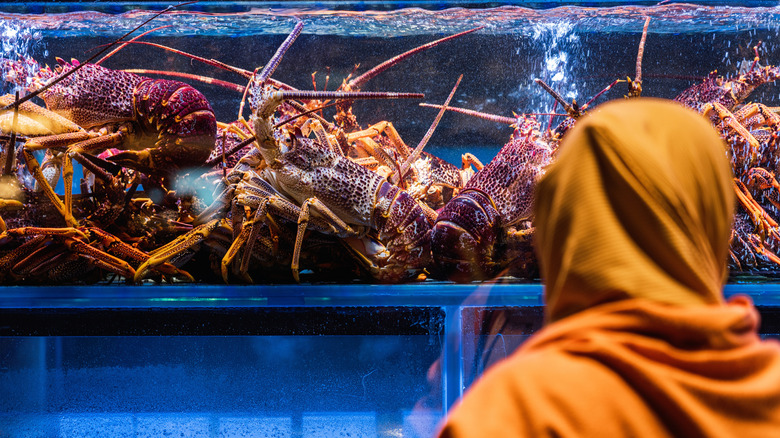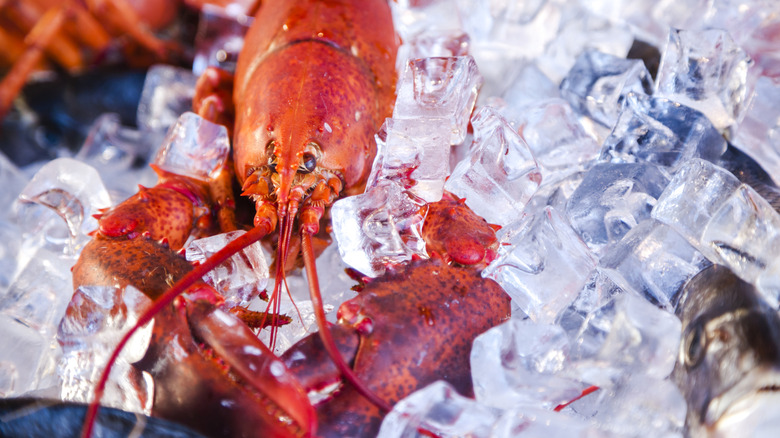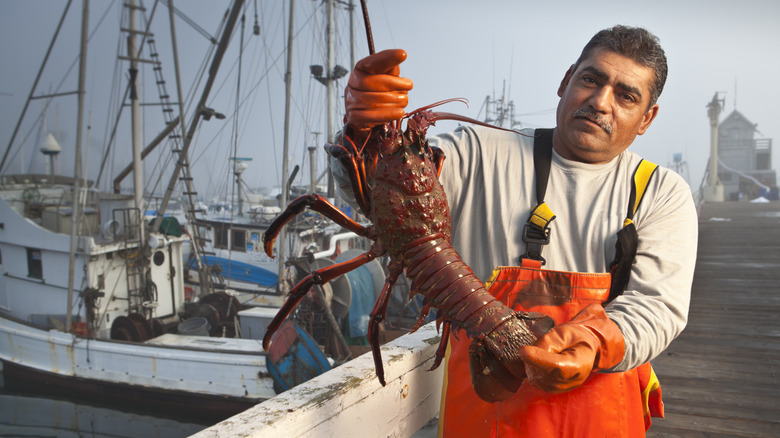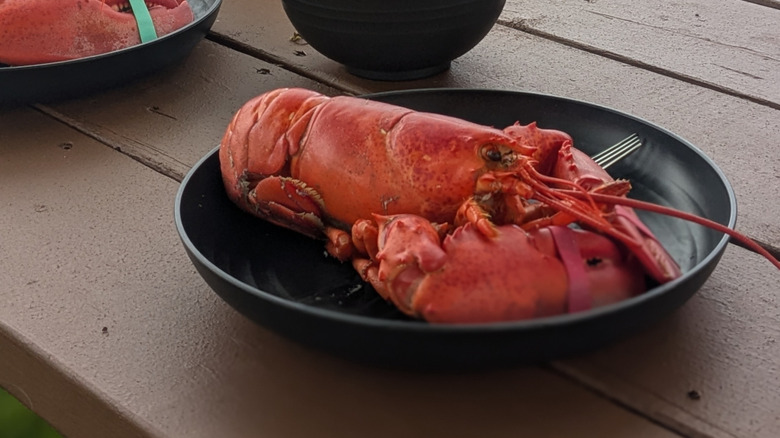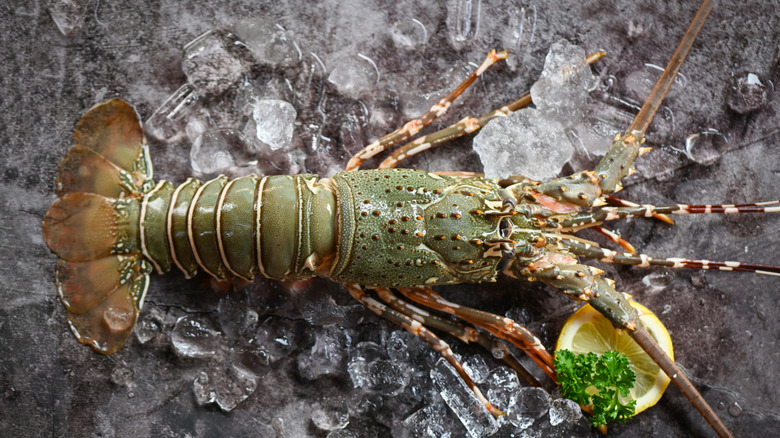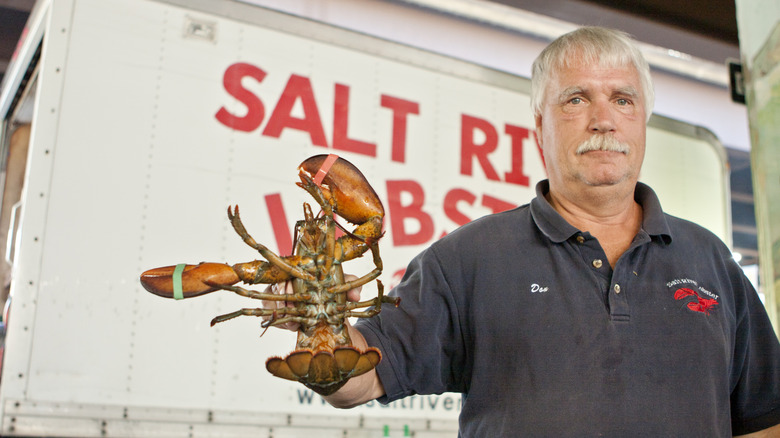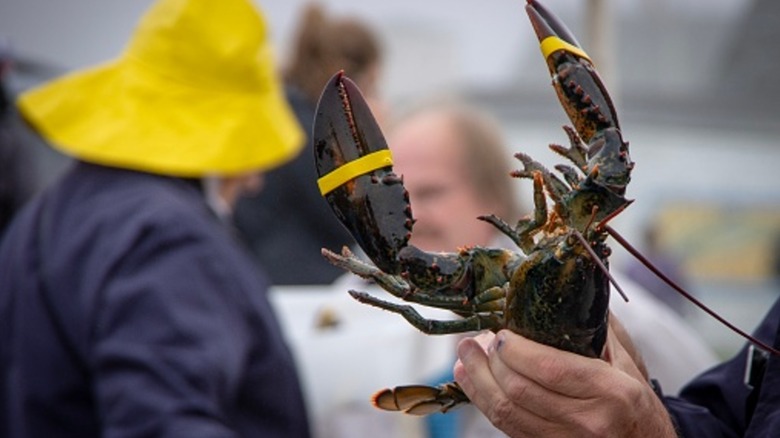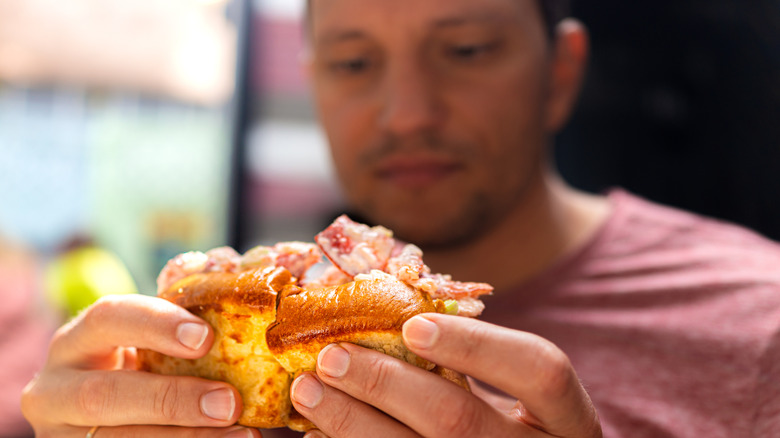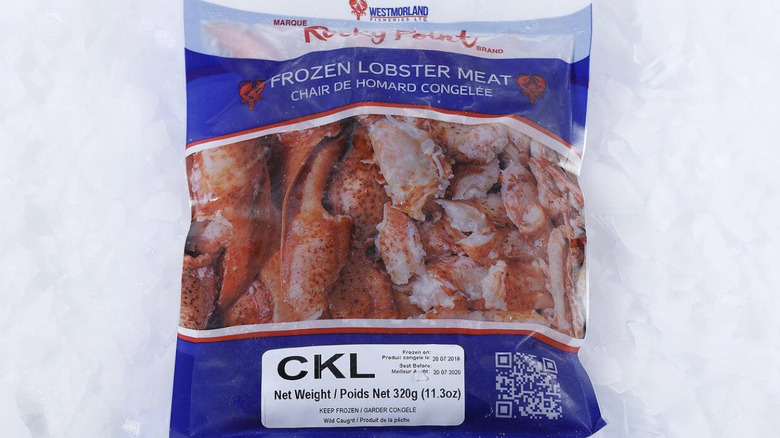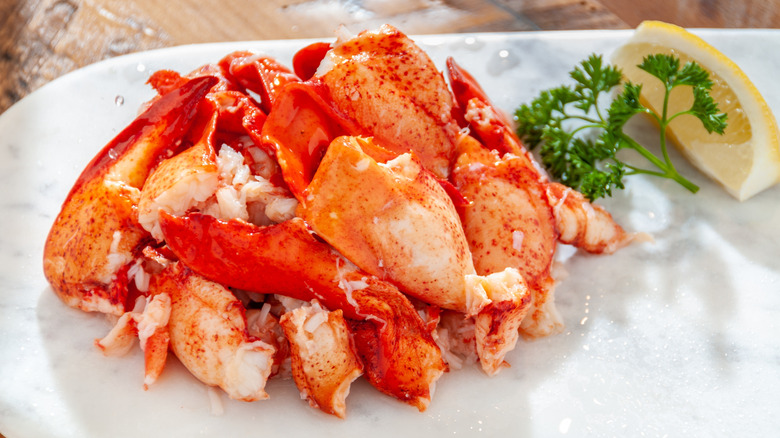11 Mistakes People Make When Buying Lobster
Whether prepared at home or enjoyed at a restaurant, lobster is an undeniable luxury. This makes it all the more surprising that the crustacean was once seen as food for the poor. In fact, it was so abundant that it was sometimes used to feed slaves and prisoners. So what changed? Over time, improvements in transportation, the refinement of the canning process, and rising demand from urban areas transformed lobster's status from lowly fare to an expensive delicacy.
Today, lobster is in high demand, fetching top dollar per pound. That's why it's important for those making the investment to get what they pay for. If you are going to splurge, it's only fair that you walk away with a lobster that's both fresh and flavorful, rather than a subpar substitute. Luckily, there are certain things to look for to ensure that the investment pays off. To help you shop with confidence, we asked chefs and other culinary experts to share their insights on the most common mistakes seafood enthusiasts make when buying lobster. Here is their advice!
1. Purchasing live lobsters that aren't moving
If you are buying a live lobster from a saltwater tank, it's important to make sure that it's actually alive — and not close to death. After all, there is a good reason why lobsters — as opposed to some other seafood — are normally kept alive before they are purchased. Once killed, the crustaceans start spoiling at a rapid pace, and it's not just due to bacteria. Lobsters and shrimp rely on enzymes in their heads — that's where their upper digestive tract is located — to break down food. After they die, these enzymes start to consume their bodies, essentially causing them to decompose from the inside. Believe it or not, this can turn their meat mushy in under an hour.
When buying a live lobster, it's important to select one that shows clear signs of life like responsive antennae and active legs, tail, and claws. Jim Foster, the owner of the Pelican Seafood Market & Grill in Ottawa, Ontario — Canada's capital city — reinforces this point, saying, "Purchasing a dying lobster is not a great way to start your lobster experience. A live lobster should be active and able to hold up its claws. Just like a good boxer." Hervé Malivert, director of culinary affairs at the Institute of Culinary Education's New York City campus, agrees, warning, "If the lobster isn't moving, it's a sign it will die in the next few hours or day."
2. Buying lobsters from dirty or overcrowded tanks
Whether you are eating lobster like a connoisseur or sending shells flying across the table, it's important that the crustacean is of the highest quality possible. It doesn't matter how fresh it was when caught if the live lobster you have your eye on hasn't been handled and stored in the appropriate conditions. In fact, dirty and overcrowded tanks are a big no-no, so look for reputable vendors with clean, well-aerated tanks with minimal crowding. If you are curious about how retail chains once handled live seafood, check out our article on the former lobster tanks at Walmart.
Nic Vanderbeeken, who personally sources and prepares lobsters for Apéritif Restaurant in Bali, Indonesia, highlights how damaging poor tank conditions can be to the quality and flavor of the crustaceans. "Keeping lobsters in dirty water or crowded tanks decreases their oxygen supply, forcing them into too much stress. Stress negatively affects the meat's quality, making it less sweet and faster to spoil. Make sure that the water is clean and the tank is not too crowded, so that lobsters can move about smoothly," Vanderbeeken says.
Proper storage doesn't end at the store tank. Once you bring your lobster home, it's important to keep it as fresh as possible until you are ready to prepare it. Since lobsters start to decompose shortly after they die, your number one priority is to keep it alive. For best results, store the lobster in the refrigerator at a temperature between 34 and 38 degrees Fahrenheit. It also helps to keep the crustacean's gills moist by covering them with a damp newspaper or towels. That said, lobsters are unlikely to stay alive for more than 40 hours.
3. Selecting lobsters with damaged or abnormal claws, shells, tails, or antennae
A healthy lobster that's going to taste great in a lobster bisque or lobster rolls shouldn't just look alive, but also intact. While a missing claw doesn't necessarily indicate an issue, it could mean that the lobster was mishandled, as highlighted by Jim Foster from the Pelican Seafood Market & Grill. "Lobsters are amazing creatures they can regrow: claws, shell and antennae but just to ensure that the meat isn't compromised it's always best to select a fully intact lobster. Please note, sometimes you get a real deal on 'culls.' These are lobster[s] that are missing a claw. Lobsters are sold by weight so these deals can be attractive as long as you are not a claw aficionado," Foster says.
A lobster with cracks, breaks, or unusual discoloration can mean that it's close to dying or already unwell. Perhaps executive chef Nic Vanderbeeken puts it best when he says: "These characteristics may indicate a lobster that has been poorly treated or is sick. An ideal lobster should have well-formed claws, a hard shell, and straight, strong antennae. Check for indicators of health, such as a tail that is straight and a shell that is sharp and glossy."
4. Always picking the largest lobsters for value
When it comes to lobster, prioritizing size over quality can leave you with a substandard meal. This is because, in theory, lobsters can live forever. Unlike other plants and animals, which eventually stop reproducing at the cellular level, lobsters have cells that continue to divide indefinitely. As such, lobsters normally don't die of old age but rather because they succumb to disease or predators. Moreover, the ocean dwellers continue to grow as they age, with the biggest lobsters on record weighing around 40 to 50 pounds.
Generally, experts are in agreement that smaller lobsters are easier to cook and taste better than their larger counterparts. One such culinary authority is chef Nic Vanderbeeken from Apéritif Restaurant, who says: "Picking the largest lobster is tempting, but not always the best selection to make. In fact, a lot of the time larger lobsters will have tougher, more bland meat that is less tender, unlike smaller lobsters which seem to have a better taste. Look for the health of the lobster and the condition of the shell rather than just its size and features."
Chef Hervé Malivert from the Institute of Culinary Education recommends purchasing lobsters between 1.25 and 2.5 pounds. "Small lobsters cook more evenly and the meat is sweeter and more tender. Larger lobsters are harder to cook properly, and the meat may be tougher and have less flavor," he says.
5. Confusing soft-shell lobsters with hard-shell lobsters
Lobsters shed their shells in a process called molting in order to grow, as explained by Jim Foster from the Pelican Seafood Market & Grill. "To grow, lobsters need to leave their old shell behind. [...] When it's time to molt, lobsters [...] slip out of their old shell leaving it behind. During this stage, lobsters have a very fragile 'soft shell.'" This is also the time when lobsters absorb water to expand their bodies and enlarge the new shell, which then gradually hardens.
Grace Vallo, a New England native and a mastermind behind the site Tastefully Grace, says that there are some major differences between soft and hard-shell lobsters. "Hard-shell lobsters have more meat, while soft-shells are easier to crack but yield less. Know what you're getting," she sums up. "Lobsters are meatier and better quality in late summer and fall. Buying lobster out of season can mean softer shells and less yield."
Soft-shell lobsters are indeed easier to break apart and may not even require a lobster cracker. On the downside, soft-shell lobsters also yield around 30% less meat per pound than hard-shell lobsters because they contain more water. Finally, opinions are divided as to which lobster type tastes better — some enjoy the sweetness of soft-shell lobster meat, while others prefer the briny flavor of hard-shell lobsters. We definitely know what side of the fence Foster sits on — he doesn't mince words, stating: "The meat [of soft-shell lobster] is not great and can resemble cottage cheese. Go for a hard-shell lobster!"
6. Assuming all lobsters are the same species
With some 75 species of lobster found around the globe, it goes without saying that not all lobsters are created equal. While you are unlikely to ever come across all of these lobster types in the U.S., it's important to know exactly what you are dealing with when buying the crustacean at your local fish market or grocery store.
To cut a long story short, there are two main types of lobster sold in the U.S., as highlighted by chef Nic Vanderbeeken. "There is a difference in lobsters depending on their origin. American lobster (Homarus Americanus) and spiny lobster (Palinuridae) are the most well-known ones. It is necessary to ask the vendor about the lobster at the time of purchase so that one does not get confused with the not-so-sweet meat of spiny lobsters and real lobsters," Vanderbeeken says.
So what are the differences between these two lobster types? Also commonly referred to as Maine lobster, the American lobster is caught in the cold Atlantic waters off the coast of Maine. It is characterized by large claws and sweet, slightly briny meat and is most abundant from June through September. Also called rock lobster, the spiny lobster is clawless and has long, spiny antennae. It can also be distinguished by a reddish-brown shell with white spots. Typically caught in Florida and California between October and March, spiny lobsters are known for their tail meat, which is slightly more intense in flavor and less juicy than the meat of Maine lobster.
7. Purchasing lobsters from unreputable vendors or roadside sellers
Obtaining lobsters from questionable sources can be risky, especially if you don't know what to look for. Those lucky enough to live in the Northeast often have access to trusted seafood markets where lobsters are kept under optimal conditions — but what about the rest of us? That's where expert advice comes in handy. Jim Foster, a seafood specialist at Pelican Seafood Market & Grill, notes, "A lobster dinner should be an awesome event. Don't take the chance of getting poor quality lobster from someone who doesn't usually offer them. When I see a cooked lobster at a grocery store I always guess at how many days ago it was cooked," he says.
Buying lobsters can be trickier for those living in the middle of the country, away from the coast. This is where doing your homework can pay off, as highlighted by chef Hervé Malivert. "Make sure to use a reputable and knowledgeable vendor who knows where the lobster came from. Make sure the store is clean and check out their social reviews. Skip roadside sellers if you are not familiar with the area and region," he says. "If you are by the sea in a big lobster fishery and you are familiar with the location, a side road or marina stand will be fine."
8. Overlooking the fact that the lobsters feel too light
Any lobster vendor worth their salt lets their customers inspect the seafood before making a purchase. This includes having a closer look at the shell, claws, and overall state of the lobsters to ensure that they are both fresh and healthy. Aside from a visual inspection, it's also important to check each lobster's weight. Any lobster that feels too light for its size is a clear warning sign.
There are a number of reasons for reduced weight in lobsters, most of which should put shoppers on alert. According to chef Hervé Malivert from the Institute of Culinary Education, an unusually light lobster can be a sign that it's dying. "A lobster's body is typically 80% water, and it will start to experience water loss after it's been harvested and removed from water," he says. Chef Nic Vanderbeeken from Apéritif Restaurant agrees that a lobster lacking heft is a reason for concern, saying, "Lobsters should be heavy and feel dense relative to their size. If a lobster feels strangely weightless, it might have been overcooked, dehydrated, or aged."
9. Assuming that lobsters with a fishy smell are normal
When buying any kind of seafood, an off smell is a good indication that it has seen better days. For instance, fresh fish should have a mild scent — anything fishy or overly sour is a clear warning sign that it has probably gone off. Just as in the case of fish, the freshness of lobsters can be assessed by their smell. Any fishy, unappetizing scent is a clear cause for concern.
So what does a fresh lobster smell like? Grace Vallo from Tastefully Grace offers her insights into the topic, noting, "Lobster should smell like the ocean: clean and slightly briny. A fishy or ammonia-like odor means it's starting to spoil and should be avoided." Nic Vanderbeeken echoes this advice, saying, "The smell of lobster is mildly salty, but if a strong odor of fish or ammonia is present, it heavily indicates the lobster is no longer fresh. Steer clear of lobsters that emit strong and nasty smells."
10. Buying pre-packaged lobsters without checking for ice crystals
Not all of us are lucky enough to be able to purchase our lobsters fresh off the boat, so it's important to know what to look for when buying lobster from a fishmonger or a grocery store. One of the main indicators of quality is whether the lobster has been flash frozen — a process that normally leaves the meat frost-free, with no visible ice crystals on the surface.
Since lobsters start decomposing as soon as they die, any crustaceans sold at supermarkets are normally flash frozen. This means that they have been frozen shortly after being caught using modern techniques. One of these is nitrogen freezing, where the lobster is cooled to -15 degrees Fahrenheit in approximately 15 minutes.
Unlike traditional freezing over a period of time, which can result in the formation of large crystals in the lobster's meat, flash freezing typically only results in microscopic ice crystals. These do less structural damage to the lobster, as they don't break down the proteins in its meat. In fact, most of the moisture in the ice crystals is drawn back into the meat during the thawing process, leaving it juicy rather than leached of flavor and texture.
11. Investing in lobsters with dull, slimy, or mushy meat
Whether raw or cooked, dull and mushy lobster meat is typically an indication that the crustacean may already be spoiled. When cracked open, raw lobster offers immediate clues about its freshness and quality. Nic Vanderbeeken highlights that ignoring these can be a costly and potentially stomach-turning mistake. "The meat should be firm and slightly translucent. If the meat shows signs of dullness or a mushy texture, the lobster may be past its shelf life or may have been stored incorrectly, leading to a very uncomfortable eating experience," Vanderbeeken says.
Just like raw lobster, cooked lobster meat should also be clear and firm in texture. Jim Foster cautions: "They should be freshly cooked. If the vendor doesn't know when they were cooked, look somewhere else. If cooked lobsters have a slimy or sticky feel do not purchase them." Anything less is bound to ruin your meal and could even lead to serious foodborne illnesses.

